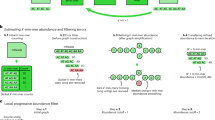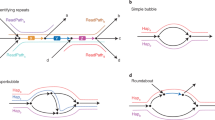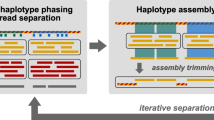Abstract
De novo assembly of metagenome samples is a common approach to the study of microbial communities. Current metagenome assemblers developed for short sequence reads or noisy long reads were not optimized for accurate long reads. We thus developed hifiasm-meta, a metagenome assembler that exploits the high accuracy of recent data. Evaluated on seven empirical datasets, hifiasm-meta reconstructed tens to hundreds of complete circular bacterial genomes per dataset, consistently outperforming other metagenome assemblers.
This is a preview of subscription content, access via your institution
Access options
Access Nature and 54 other Nature Portfolio journals
Get Nature+, our best-value online-access subscription
$29.99 / 30 days
cancel any time
Subscribe to this journal
Receive 12 print issues and online access
$259.00 per year
only $21.58 per issue
Buy this article
- Purchase on Springer Link
- Instant access to full article PDF
Prices may be subject to local taxes which are calculated during checkout

Similar content being viewed by others
Data availability
HiFi data were obtained from NCBI Sequence Read Archive (SRA) with accession numbers shown in Table 1. All generated assemblies and underlying data for the figures are available at https://zenodo.org/record/6330282. ZymoBIOMICS mock reference genomes were downloaded from https://s3.amazonaws.com/zymo-files/BioPool/D6331.refseq.zip. The list of reference genomes in the ATCC mock community is available at https://www.atcc.org/products/msa-1003. CheckM database: https://data.ace.uq.edu.au/public/CheckM_databases/checkm_data_2015_01_16.tar.gz. GTDB-Tk database: https://data.ace.uq.edu.au/public/gtdb/data/releases/release95/95.0/auxillary_files/. Source data are provided with this paper.
Code availability
Hifiasm-meta is available at https://github.com/xfengnefx/hifiasm-meta.
References
Lapidus, A. L. & Korobeynikov, A. I. Metagenomic data assembly—the way of decoding unknown microorganisms. Front. Microbiol. 12, 613791 (2021).
Almeida, A. et al. A new genomic blueprint of the human gut microbiota. Nature 568, 499–504 (2019).
Chen, L.-X., Anantharaman, K., Shaiber, A., Eren, A. M. & Banfield, J. F. Accurate and complete genomes from metagenomes. Genome Res. 30, 315–333 (2020).
Kang, D. D. et al. MetaBAT 2: an adaptive binning algorithm for robust and efficient genome reconstruction from metagenome assemblies. PeerJ 7, e7359 (2019).
Kolmogorov, M. et al. metaFlye: scalable long-read metagenome assembly using repeat graphs. Nat. Methods 17, 1103–1110 (2020).
Kolmogorov, M., Yuan, J., Lin, Y. & Pevzner, P. A. Assembly of long, error-prone reads using repeat graphs. Nat. Biotechnol. 37, 540–546 (2019).
Nurk, S. et al. HiCanu: accurate assembly of segmental duplications, satellites, and allelic variants from high-fidelity long reads. Genome Res. 30, 1291–1305 (2020).
Cheng, H., Concepcion, G. T., Feng, X., Zhang, H. & Li, H. Haplotype-resolved de novo assembly using phased assembly graphs with hifiasm. Nat. Methods 18, 170–175 (2021).
Cao, C. et al. Reconstruction of microbial haplotypes by integration of statistical and physical linkage in scaffolding. Mol. Biol. Evol. 38, 2660–2672 (2021).
Hui, J., Shomorony, I., Ramchandran, K. & Courtade, T. A. Overlap-based genome assembly from variable-length reads. In IEEE International Symposium on Information Theory, ISIT 2016 1018–1022 (IEEE, 2016).
Parks, D. H., Imelfort, M., Skennerton, C. T., Hugenholtz, P. & Tyson, G. W. CheckM: assessing the quality of microbial genomes recovered from isolates, single cells, and metagenomes. Genome Res. 25, 1043–1055 (2015).
Bowers, R. M. et al. Minimum information about a single amplified genome (misag) and a metagenome-assembled genome (mimag) of bacteria and archaea. Nat. Biotechnol. 35, 725–731 (2017).
Ondov, B. D. et al. Mash: fast genome and metagenome distance estimation using minhash. Genome Biol. 17, 132 (2016).
Bickhart, D. M. et al. Generating lineage-resolved, complete metagenome-assembled genomes from complex microbial communities. Nat. Biotechnol. https://doi.org/10.1038/s41587-021-01130-z (2022).
Moss, E. L., Maghini, D. G. & Bhatt, A. S. Complete, closed bacterial genomes from microbiomes using nanopore sequencing. Nat. Biotechnol. 38, 701–707 (2020).
Vicedomini, R., Quince, C., Darling, A. E. & Chikhi, R. Strainberry: automated strain separation in low-complexity metagenomes using long reads. Nat. Commun. 12, 4485 (2021).
Hon, T. et al. Highly accurate long-read HiFi sequencing data for five complex genomes. Sci. Data 7, 399 (2020).
Chaumeil, P.-A., Mussig, A. J., Hugenholtz, P. & Parks, D. H. GTDB-Tk: a toolkit to classify genomes with the genome taxonomy database. Bioinformatics 36, 1925–1927 (2019).
Asnicar, F., Weingart, G., Tickle, T. L., Huttenhower, C. & Segata, N. Compact graphical representation of phylogenetic data and metadata with graphlan. PeerJ 3, e1029 (2015).
Tange, O. GNU Parallel - the command-line power tool. The USENIX Magazine 36, 42–47 (2011).
Li, H. et al. The sequence alignment/map format and samtools. Bioinformatics 25, 2078–2079 (2009).
Li, H. Minimap2: pairwise alignment for nucleotide sequences. Bioinformatics 34, 3094–3100 (2018).
Sieber, C. M. K. et al. Recovery of genomes from metagenomes via a dereplication, aggregation and scoring strategy. Nat. Microbiol. 3, 836–843 (2018).
Nawrocki, E. P. & Eddy, S. R. Infernal 1.1: 100-fold faster RNA homology searches. Bioinformatics 29, 2933–2935 (2013).
Acknowledgements
We thank W. Fan from Agricultural Genomics Institute, Shenzhen, China, for sharing the chicken gut dataset. This study was supported by US National Institutes of Health (grant R01HG010040 and U01HG010971, to H.L.). The funders had no role in study design, data collection and analysis, decision to publish or preparation of the manuscript.
Author information
Authors and Affiliations
Contributions
X.F. and H.L. conceived the project, designed the algorithm and wrote the manuscript. X.F. implemented the algorithm and evaluated the metagenome assemblies. H.C. helped with the algorithm implementation. D.P. helped with assembly evaluations. All authors helped with the data analysis and revised the manuscript.
Corresponding author
Ethics declarations
Competing interests
D.P. is an employee of Pacific Biosciences. H.L. is a consultant of Integrated DNA Technologies and on the Scientific Advisory Boards of Sentieon and Innozeen. The remaining authors declare no competing interests.
Peer review
Peer review information
Nature Methods thanks Mads Albertsen and the other, anonymous, reviewer(s) for their contribution to the peer review of this work. Lei Tang was the primary editor on this article and managed its editorial process and peer review in collaboration with the rest of the editorial team.
Additional information
Publisher’s note Springer Nature remains neutral with regard to jurisdictional claims in published maps and institutional affiliations.
Extended data
Extended Data Fig. 1 The hifiasm-meta assembly graph of the sheepA dataset.
Short disconnected contigs are not shown.
Extended Data Fig. 2 Yak QV score correlated with contig coverage.
Plots showing >1Mb contigs in sheepB assemblies. Contig coverage was estimated by jgi_summarize_bam_contig_depths from metabat2, and alignment was done with minimap2 -a -k 19 -w 10 -I 10G -g 5000 -r 2000 –lj-min-ratio 0.5 -A 2 -B 5 -O 5,56 -E 4,1 -z 400,50. Hifiasm-meta assembled 37 contigs without k-mer errors. HiCanu and metaFlye each assembled 4 contigs without k-mer errors.
Supplementary information
Supplementary Tables
Supplementary Tables 1–6.
Source data
Source Data Fig. 1
The data points used to plot Fig. 1.
Source Data Extended Data Fig. 1
Instruction for redirecting the interested reader to data release (on Zenodo) for the assembly graph, which is the underlying data for Extended Data Fig. 1.
Source Data Extended Data Fig. 2
The data points used to plot Extended Data Fig. 2.
Rights and permissions
About this article
Cite this article
Feng, X., Cheng, H., Portik, D. et al. Metagenome assembly of high-fidelity long reads with hifiasm-meta. Nat Methods 19, 671–674 (2022). https://doi.org/10.1038/s41592-022-01478-3
Received:
Accepted:
Published:
Issue Date:
DOI: https://doi.org/10.1038/s41592-022-01478-3
This article is cited by
-
Evaluating and improving the representation of bacterial contents in long-read metagenome assemblies
Genome Biology (2024)
-
Unraveling metagenomics through long-read sequencing: a comprehensive review
Journal of Translational Medicine (2024)
-
High-quality metagenome assembly from long accurate reads with metaMDBG
Nature Biotechnology (2024)
-
Tools for microbial single-cell genomics for obtaining uncultured microbial genomes
Biophysical Reviews (2024)
-
Genomic insight into the origin, domestication, dispersal, diversification and human selection of Tartary buckwheat
Genome Biology (2024)



